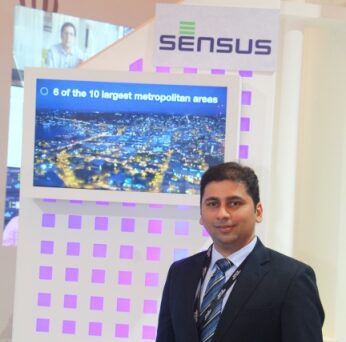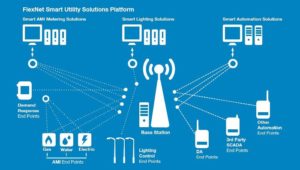
By 2020, India plans to install 50 million smart electric meters and is estimated to invest $449 billion in developing smart grid technologies over a period of 10 years starting from 2017. With the country’s demand for electricity growing rapidly, India’s power sector is undergoing a massive transformation. In the next five to six years, India hopes to have a smart meter at every home. An increase in the usage of technologies such as Internet of Things and Cloud-based services are fuelling the government plans to build 100 smart cities across the country.
The most critical element for any successful smart city is the choice of technology for the communication network. So what are the challenges in creating that network? Before we delve deeper into the subject, it is essential to understand a few key things.
The term ‘Internet of Things’ covers a wide variety of different connected devices. At Mobile World Congress this year, these ‘things’ being exhibited included thermostats, warehouse technology, wearables, and even the ubiquitous connected fridge.
With so many connected devices lumped together under the IoT banner, it is important to understand that there are marked differences between them, in order to build the right communications network for the purpose. Some devices are in one fixed place such as smart meters, while wearables, for example, are constantly on the move. And while all connected devices will produce data, critical applications such as smart utilities will produce more important data than activity trackers or some of the more outlandish proposals such as L’Oreal’s connected mascara.
There is no standard connected device, and understanding this is vital when it comes to rolling out smart utilities. Several countries across the world, including India, are actively deploying smart meters. India is looking to create a smart communication network in the next five to six years and had in 2010 created the India Smart Grid Forum (ISGF), a PPP initiative by the Ministry of Power, for accelerated development of smart grid technologies in the Indian power sector. India plans to implement eight smart grid pilot projects with an investment of US$10 million. In the EU, all countries must replace 80 per cent of electricity meters with smart meters by 2020. Those who haven’t yet begun this process are making key decisions and putting processes in place to make this happen. In the US, smart meter deployments are expected to cross 90 million by 2020.
Much of the success of these deployments will depend on the communication network selected. Cellular, Long Range Radio (LRR) and mesh solutions have all been used for previous smart meter rollouts. However, there are two big questions that need to be considered as part of this selection process: Will the preferred technology reach nearly every smart meter in the country without having to ‘fill in the gaps’? And will the connections to these meters be reliable enough for the data produced by the meters to produce real-time insight, and be capable of controlling remote telemetry devices?
A fundamental choice must be made with this, and with any IoT roll out that involves critical infrastructure: Use the existing cellular infrastructure or use a dedicated network to carry this vital data. While IoT has gained currency as a term to encapsulate all connected devices, the wide variety of devices means that a number of connection technologies are viable for different applications – there will be no one standard.
With so many connected devices lumped together under the Internet of Things banner, it is important to understand that there are marked differences between them, in order to build the right communications network.
There is also the issue of rural coverage. Cellular networks work best when it comes to reaching phones and tablets in dense urban environments. Reaching remote rural areas – and especially deep into buildings where meters are located – is more challenging. Most countries are a combination of built-up cities and towns separated with rural land, small villages and farms so the selected technology must be capable of reaching and establishing first-time connections in all of these areas.
There are different technologies being considered to help connect the Internet of Things, but operators will need to manage massive increases in data and signaling traffic from all of these non-critical connected devices.
Critical data must be prioritised and given a dedicated network. A fitness band having to wait twenty minutes in order to synchronise its data is an inconvenience, but the data from smart meters will be used to create real-time insights to balance and maintain a vital piece of infrastructure.

Long Range Radio, on the other hand, is a utility-grade solution, offering the connectivity, reliability and security that a smart energy network requires. It is the only communications technology that can achieve more than 99.5% coverage with first time connection, through a technology which is completely dedicated to the utility’s critical national infrastructure. No need for expensive ‘in-fill’ technologies to bridge the gap. It is also proven as utility-grade through roll-outs across the globe, connecting water, gas and electricity meters first time in the UK, Germany, China, the USA and many others. These rollouts show Long Range Radio to be a technology that works already, rather than one that’s predicted to work.
For a smart meter project to be fully successful means selecting a proven communication network that will cover close to 100% of the population regardless of location or building style, be totally secure and expand to accommodate future applications. Expecting smart meters to be just another ‘thing’ means fundamentally misunderstanding the diverse requirements of connected devices- that some data is of limited importance, and some will be of critical importance.
A smart communications network is the basic requirement to run a smart grid efficiently. Energy and water utilities have been at the forefront of using IoT and connected utilities should be prioritised over other connected devices such as wearables or smart TVs. A smart grid is probably the largest installation of IoT network—from the power plant to the consumers, including transmission and distribution networks—and as the number of ‘things’ on the network increase, so will the need for increased two-way communication. Hence, this critical infrastructure must have spectrum which is dedicated to the utility to avoid jamming or interference.
India has the third largest electricity transmission and distribution network in the world. Smart meters, along with IoT sensors, a modern communication infrastructure and energy management solutions is the antidote that India needs to help tackle electricity theft and improve reliability.
[About the author: Amit Vaidya is Director- Strategic Customer Team , Sensus India.]


